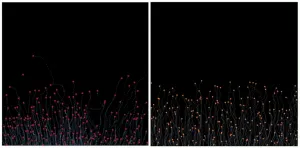(Press-News.org) When fighting disease, our immune cells need to reach their target quickly. Researchers at the Institute of Science and Technology Austria (ISTA) now discovered that immune cells actively generate their own guidance system to navigate through complex environments. This challenges earlier notions about these movements. The researchers’ findings, published in the journal Science Immunology, enhance our knowledge of the immune system and offer potential new approaches to improve human immune response.
Immunologic threats like germs or toxins can arise everywhere inside the human body. Luckily, the immune system—our very own protective shield—has its intricate ways of coping with these threats. For example, a crucial aspect of our immune response involves the coordinated collective movement of immune cells during infection and inflammation. But how do our immune cells know which way to go?
A group of scientists from the Sixt group and the Hannezo group at the Institute of Science and Technology Austria (ISTA) addressed this question. In their study, published today in Science Immunology, the researchers shed light on the immune cells’ ability to collectively migrate through complex environments.
Dendritic cells — The Messengers
Dendritic cells (DCs) are one of the key players in our immune response. They function as a messenger between the innate response—the body's first reaction to an invader, and the adaptive response—a delayed reaction that targets very specific germs and creates memories to fight off future infections. Like detectives, DCs scan tissues for intruders. Once they locate an infection site, they are activated and immediately migrate to the lymph nodes, where they hand over the battle plan and initiate the next steps in the cascade.
Their migration towards the lymph nodes is guided by chemokines—small signaling proteins released from lymph nodes—that establish a gradient. In the past, it was believed that DCs and other immune cells react to this external gradient, moving along towards a higher concentration. However, novel research conducted at ISTA now challenges this notion.
One receptor — two functions
The scientists took a close look at a receptor—a surface structure found on activated DCs called “CCR7”. CCR7’s essential function is to bind to a lymph node-specific molecule (CCL19), which triggers the next steps of the immune response. ”We found that CCR7 not only senses CCL19 but also actively contributes to shaping the distribution of chemokine concentrations,” Jonna Alanko, a former postdoc from the lab of Michael Sixt, explains.
Using different experimental techniques, they demonstrated that as DCs migrate, they take up and internalize chemokines via the CCR7 receptor, resulting in local depletion of chemokine concentration. With less signaling molecules around, they move further into higher chemokine concentrations. This dual function allows immune cells to generate their own guidance cues to orchestrate their collective migration more effectively.
Movement depends on cell population
To understand this mechanism quantitatively at the multicellular scale, Alanko and colleagues teamed up with theoretical physicists Edouard Hannezo and Mehmet Can Ucar, also at ISTA. With their expertise in cell movement and dynamics, they established computer simulations that were able to reproduce Alanko’s experiments. With these simulations, the scientists predicted that the dendritic cells’ movement not only depends on their individual responses to the chemokine but also on the density of the cell population. ”This was a simple but nontrivial prediction; the more cells there are the sharper the gradient they generate—it really highlights the collective nature of this phenomenon!” says Can Ucar.
Additionally, the researchers found that T-cells—specific immune cells that destroy harmful germs—also benefit from this dynamic interplay to enhance their own directional movement. “We are eager to find out more about this novel interaction principle between cell populations with ongoing projects,” the physicist continues.
Enhancing the immune response
The discoveries are a step in a new direction for how cells move inside our bodies. In contradiction to what was previously believed, immune cells not only respond to chemokines, but they also play an active role in shaping their own environment by consuming these chemical signals. This dynamic regulation of signaling cues provides an elegant strategy to guide their own movement and that of other immune cells.
This research has significant implications for our understanding of how immune responses are coordinated within the body. By uncovering these mechanisms, scientists could potentially design new strategies to enhance immune cell recruitment to specific sites, such as tumor cells or areas of infection.
---
Information on animal studies:
In order to better understand fundamental processes, for example, in the fields of neuroscience, immunology, or genetics, the use of animals in research is indispensable. No other methods, such as in silico models, can serve as an alternative. The animals are raised, kept, and treated according to the strict regulations of Austrian law. All animal procedures are approved by the Federal Ministry of Education, Science and Research.
END
Immune cells shape their own path
Scientists at ISTA show how immune cells migrate along self-generated gradients
2023-09-01
ELSE PRESS RELEASES FROM THIS DATE:
Network-based approaches open a new avenue to classify and treat rare diseases
2023-09-01
Scientists at CeMM, Max Perutz Labs, and St. Anna Children’s Cancer Research Institute in Vienna have achieved a significant advancement in the research of rare immune system disorders. Through a network-based approach, they have reclassified approximately 200 rare diseases. Initial comparisons with clinical data already demonstrate how this can enhance the prediction of treatment efficacy. Moreover, the study reveals for the first time the strong similarities between the molecular mechanisms of rare diseases and ...
Warming climate worsens groundwater depletion rates in India
2023-09-01
Increased withdrawals of groundwater resources are accelerating groundwater depletion rates in India, a groundwater depletion hotspot, a new study finds. The study, published today in the journal Science Advances, is led by University of Oklahoma Department of Geography and Environmental Sustainability assistant professor Nishan Bhattarai.
Bhattarai and his collaborators found that under a business-as-usual scenario of groundwater use for irrigation, warming may triple the groundwater depletion rates. Approximately 60% of India’s irrigated agriculture depends on the threatened groundwater. The results of the study indicate that adaptation ...
Groundwater depletion rates in India could triple in coming decades as climate warms, study shows
2023-09-01
EMBARGOED FOR RELEASE AT 2 P.M. ET FRIDAY, SEPT. 1, 2023
Photos
ANN ARBOR—A new University of Michigan-led study finds that farmers in India have adapted to warming temperatures by intensifying the withdrawal of groundwater used for irrigation. If the trend continues, the rate of groundwater loss could triple by 2080, further threatening India's food and water security.
Reduced water availability in India due to groundwater depletion and climate change could threaten the livelihoods of more than one-third of the country's 1.4 billion ...
Toxic molds, fossil fuels, antibiotics linked to chemical intolerance: Survey
2023-09-01
SAN ANTONIO (Sept. 1, 2023) — What initiates chemical intolerance (CI)? In a newly released survey of thousands of U.S. adults, respondents most frequently cited exposures to biological sources, such as mold and algae “blooms,” and/or fossil fuels, their combustion products and synthetic chemical derivatives such as pesticides, plastics and persistent organic pollutants.
It's an issue in the news, as toxic mold spawned by the moisture left behind by flood waters from Hurricane ...
nTIDE August 2023 Jobs Report: Record-breaking employment trend continues for people with disabilities
2023-09-01
East Hanover, NJ – September 1, 2023 – Labor Day weekend brings more good news for people with disabilities, with record-breaking highs for labor force participation and employment-to-population ratio, according to today’s National Trends in Disability Employment – semi-monthly update (nTIDE), issued by Kessler Foundation and the University of New Hampshire’s Institute on Disability (UNH-IOD). In comparison, both indicators declined slightly for people without disabilities.
Month-to-Month nTIDE Numbers (comparing July 2023 to August 2023)
Based on data from the U.S. Bureau of Labor Statistics (BLS) Jobs Report released ...
Air pollution has decreased across the US, but new Yale research finds health burdens remain unequal among racial groups
2023-09-01
New Haven, Conn. — Health benefits that have resulted from reductions in fine particulate air pollution aren’t distributed equally among populations in the U.S., a new Yale-led study finds. Racial and ethnic minorities — and Black people in particular — still experience disproportionately high rates of cardiovascular disease-related deaths caused by exposure to fine particulate matter, according to the research.
The findings were published Aug. 31 in Nature Human Behavior.
Fine particulate matter, also known as PM2.5, consists of particles or droplets smaller than 2.5 micrometers in diameter, or ...
Precarious employment conditions can increase risk of early death
2023-09-01
People without a secure job contract can reduce their risk of premature death by 20 per cent if they gain permanent employment, a study from Karolinska Institutet published in The Journal of Epidemiology and Community reports. According to the researchers, the results indicate that job security on the Swedish labour market needs to improve.
Precarious employment is a term that is used to describe jobs with short contracts (e.g. temping), low wages and a lack of influence and rights, all of which lead to a working life without predictability and security.
In the present study, the researchers have examined how this affects the risk of death.
“This is ...
Alaska scientists heading to Greenland for glacier research, museum project
2023-09-01
University of Alaska Fairbanks scientists will make several trips to Greenland over two years to study how meltwater and the ocean affect glacial ice loss.
The four-year research project, funded by a $565,000 National Science Foundation grant, will create a traveling museum exhibit about the drivers of Arctic climate change. The exhibit will appear first at the University of Alaska Museum of the North, likely in 2026.
Ice loss from the polar ice sheets is the largest anticipated contributor to global mean-sea-level rise in the coming century. Scientists need to better understand glacier behavior to improve predictions of sea-level rise.
At the study’s conclusion, ...
Native American patients were sicker and more likely to die during the COVID-19 pandemic, UNM researchers find
2023-09-01
When the COVID-19 pandemic swept into New Mexico in the spring of 2020, seriously ill patients from all over the state were brought to The University of New Mexico Hospital in Albuquerque, where many wound up in intensive care, breathing with the help of ventilators.
Early on, researchers from the UNM Center for Global Health launched a study of hospitalized patients to gauge the severity of symptoms from the infection, gathering data on 475 patients from April 2020 through December 2021.
In paper published this week in PNAS Nexus, ...
New research explains “Atlantification” of the Arctic Ocean
2023-09-01
New research by an international team of scientists explains what’s behind a stalled trend in Arctic Ocean sea ice loss since 2007. The findings indicate that stronger declines in sea ice will occur when an atmospheric feature known as the Arctic dipole reverses itself in its recurring cycle.
The many environmental responses to the Arctic dipole are described in a paper published online today in the journal Science. This analysis helps explain how North Atlantic water influences Arctic Ocean climate. Scientists call it Atlantification.
The research is led by professor Igor Polyakov of the University of Alaska Fairbanks College of ...
LAST 30 PRESS RELEASES:
Tracing the quick synthesis of an industrially important catalyst
New software sheds light on cancer’s hidden genetic networks
UT Health San Antonio awarded $3 million in CPRIT grants to bolster cancer research and prevention efforts in South Texas
Third symposium spotlights global challenge of new contaminants in China’s fight against pollution
From straw to soil harmony: International team reveals how biochar supercharges carbon-smart farming
Myeloma: How AI is redrawing the map of cancer care
Manhattan E. Charurat, Ph.D., MHS invested as the Homer and Martha Gudelsky Distinguished Professor in Medicine at the University of Maryland School of Medicine
Insilico Medicine’s Pharma.AI Q4 Winter Launch Recap: Revolutionizing drug discovery with cutting-edge AI innovations, accelerating the path to pharmaceutical superintelligence
Nanoplastics have diet-dependent impacts on digestive system health
Brain neuron death occurs throughout life and increases with age, a natural human protein drug may halt neuron death in Alzheimer’s disease
SPIE and CLP announce the recipients of the 2025 Advanced Photonics Young Innovator Award
Lessons from the Caldor Fire’s Christmas Valley ‘Miracle’
Ant societies rose by trading individual protection for collective power
Research reveals how ancient viral DNA shapes early embryonic development
A molecular gatekeeper that controls protein synthesis
New ‘cloaking device’ concept to shield sensitive tech from magnetic fields
Researchers show impact of mountain building and climate change on alpine biodiversity
Study models the transition from Neanderthals to modern humans in Europe
University of Phoenix College of Doctoral Studies releases white paper on AI-driven skilling to reduce burnout and restore worker autonomy
AIs fail at the game of visual “telephone”
The levers for a sustainable food system
Potential changes in US homelessness by ending federal support for housing first programs
Vulnerability of large language models to prompt injection when providing medical advice
Researchers develop new system for high-energy-density, long-life, multi-electron transfer bromine-based flow batteries
Ending federal support for housing first programs could increase U.S. homelessness by 5% in one year, new JAMA study finds
New research uncovers molecular ‘safety switch’ shielding cancers from immune attack
Bacteria resisting viral infection can still sink carbon to ocean floor
Younger biological age may increase depression risk in older women during COVID-19
Bharat Innovates 2026 National Basecamp Showcases India’s Most Promising Deep-Tech Ventures
Here’s what determines whether your income level rises or falls
[Press-News.org] Immune cells shape their own pathScientists at ISTA show how immune cells migrate along self-generated gradients






